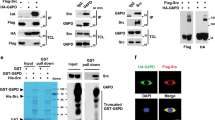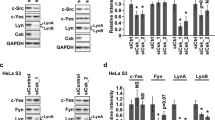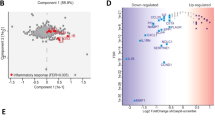Abstract
Src activation has been associated with colon cancers but the mechanism underlying Src activation is largely unknown. Csk-homologous kinase (CHK) can inhibit the kinase activity of certain Src kinase family members in vitro by phosphorylating the C-terminal tyrosine and by a non-catalytic mechanism. CHK was previously reported to be expressed primarily in brain and hematopoietic cells. We report herein that CHK is also expressed in normal colon cell lines. Furthermore, CHK protein levels are significantly decreased in various colon cancer cell lines and the decrease correlates with the increased specific activity of Src in these cell lines, while the level of the other Src inhibitory kinase, C-terminal Src kinase, is not significantly changed. CHK is also expressed in normal colon tissues but its expression level is decreased in colon cancer tissues collected from the same patients. Immunofluorescence microscopy shows that CHK colocalizes with Src in normal colon FHC cells. Overexpression of CHK in colon cancer cells results in inactivation of Src without phosphorylating Y530 at its C-terminus. In addition, CHK suppresses anchorage-independent cell growth and cell invasion of colon cancer cells. These results reveal a potentially important role for CHK in Src activation and tumorigenicity in colon cancer cells.
This is a preview of subscription content, access via your institution
Access options
Subscribe to this journal
Receive 50 print issues and online access
$259.00 per year
only $5.18 per issue
Buy this article
- Purchase on Springer Link
- Instant access to full article PDF
Prices may be subject to local taxes which are calculated during checkout








Similar content being viewed by others
References
Avraham S, Jiang S, Ota S, Fu Y, Deng B, Dowler LL et al. (1995). Structural and functional studies of the intracellular tyrosine kinase MATK gene and its translated product. J Biol Chem 270: 1833–1842.
Bennett BD, Cowley S, Jiang S, London R, Deng B, Grabarek J et al. (1994). Identification and characterization of a novel tyrosine kinase from megakaryocytes. J Biol Chem 269: 1068–1074.
Bjorge JD, Jakymiw A, Fujita DJ . (2000). Selected glimpses into the activation and function of Src kinase. Oncogene 19: 5620–5635.
Bougeret C, Jiang S, Keydar I, Avraham H . (2001). Functional analysis of Csk and CHK kinases in breast cancer cells. J Biol Chem 276: 33711–33720.
Cam WR, Masaki T, Shiratori Y, Kato N, Ikenoue T, Okamoto M et al. (2001). Reduced C-terminal Src kinase activity is correlated inversely with pp60(c-src) activity in colorectal carcinoma. Cancer 92: 61–70.
Chong YP, Chan AS, Chan KC, Williamson NA, Lerner EC, Smithgall TE et al. (2006). C-terminal Src kinase-homologous kinase (CHK), a unique inhibitor inactivating multiple active conformations of Src family tyrosine kinases. J Biol Chem 281: 32988–32999.
Chong YP, Mulhern TD, Zhu HJ, Fujita DJ, Bjorge JD, Tantiongco JP et al. (2004). A novel non-catalytic mechanism employed by the C-terminal Src-homologous kinase to inhibit Src-family kinase activity. J Biol Chem 279: 20752–20766.
Chow LM, Davidson D, Fournel M, Gosselin P, Lemieux S, Lyu MS et al. (1994a). Two distinct protein isoforms are encoded by ntk, a csk-related tyrosine protein kinase gene. Oncogene 9: 3437–3448.
Chow LM, Jarvis C, Hu Q, Nye SH, Gervais FG, Veillette A et al. (1994b). Ntk: a Csk-related protein-tyrosine kinase expressed in brain and T lymphocytes. Proc Natl Acad Sci USA 91: 4975–4979.
Davidson D, Chow LM, Veillette A . (1997). Chk, a Csk family tyrosine protein kinase, exhibits Csk-like activity in fibroblasts, but not in an antigen-specific T-cell line. J Biol Chem 272: 1355–1362.
Ershler MA, Samokhvalov IM, Belyavsky AV, Visser JW . (1995). Genomic structure and alternative splicing of the murine bhk/ctk/ntk gene. FEBS Lett 375: 50–52.
Fearon ER, Vogelstein B . (1990). A genetic model for colorectal tumorigenesis. Cell 61: 759–767.
Fincham VJ, Brunton VG, Frame MC . (2000). The SH3 domain directs acto-myosin-dependent targeting of v-Src to focal adhesions via phosphatidylinositol 3-kinase. Mol Cell Biol 20: 6518–6536.
Fincham VJ, Frame MC . (1998). The catalytic activity of Src is dispensable for translocation to focal adhesions but controls the turnover of these structures during cell motility. EMBO J 17: 81–92.
Hirao A, Hamaguchi I, Suda T, Yamaguchi N . (1997). Translocation of the Csk homologous kinase (Chk/Hyl) controls activity of CD36-anchored Lyn tyrosine kinase in thrombin-stimulated platelets. EMBO J 16: 2342–2351.
Hirao A, Huang XL, Suda T, Yamaguchi N . (1998). Overexpression of C-terminal Src kinase homologous kinase suppresses activation of Lyn tyrosine kinase required for VLA5-mediated Dami cell spreading. J Biol Chem 273: 10004–10010.
Hunter T . (1987). A tail of two src's: mutatis mutandis. Cell 49: 1–4.
Ilyas M, Straub J, Tomlinson IP, Bodmer WF . (1999). Genetic pathways in colorectal and other cancers. Eur J Cancer 35: 1986–2002.
Irby RB, Mao W, Coppola D, Kang J, Loubeau JM, Trudeau W et al. (1999). Activating SRC mutation in a subset of advanced human colon cancers. Nat Genet 21: 187–190.
Irby RB, Yeatman TJ . (2000). Role of Src expression and activation in human cancer. Oncogene 19: 5636–5642.
Isozumi T, Yamada E, Hazama F, Handa J . (1997). Altered expression of src tyrosine kinase after axotomy. Acta Neuropathol (Berl) 93: 438–442.
Jove R, Hanafusa H . (1987). Cell transformation by the viral src oncogene. Annu Rev Cell Biol 3: 31–56.
Kim S, Zagozdzon R, Meisler A, Baleja JD, Fu Y, Avraham S et al. (2002). Csk homologous kinase (CHK) and ErbB-2 interactions are directly coupled with CHK negative growth regulatory function in breast cancer. J Biol Chem 277: 36465–36470.
Kim SO, Avraham S, Jiang S, Zagozdzon R, Fu Y, Avraham HK . (2004). Differential expression of Csk homologous kinase (CHK) in normal brain and brain tumors. Cancer 101: 1018–1027.
Kinzler KW, Vogelstein B . (1996). Lessons from hereditary colorectal cancer. Cell 87: 159–170.
Klages S, Adam D, Class K, Fargnoli J, Bolen JB, Penhallow RC . (1994). Ctk: a protein-tyrosine kinase related to Csk that defines an enzyme family. Proc Natl Acad Sci USA 91: 2597–2601.
Krueger JG, Wang E, Garber EA, Goldberg AR . (1980). Differences in intracellular location of pp60src in rat and chicken cells transformed by Rous sarcoma virus. Proc Natl Acad Sci USA 77: 4142–4146.
Kuismanen SA, Holmberg MT, Salovaara R, de la Chapelle A, Peltomaki P . (2000). Genetic and epigenetic modification of MLH1 accounts for a major share of microsatellite-unstable colorectal cancers. Am J Pathol 156: 1773–1779.
Kuo SS, Moran P, Gripp J, Armanini M, Phillips HS, Goddard A et al. (1994). Identification and characterization of Batk, a predominantly brain-specific non-receptor protein tyrosine kinase related to Csk. J Neurosci Res 38: 705–715.
Levin VA . (2004). Basis and importance of Src as a target in cancer. Cancer Treat Res 119: 89–119.
Nakayama Y, Yamaguchi N . (2005). Multi-lobulation of the nucleus in prolonged S phase by nuclear expression of chk tyrosine kinase. Exp Cell Res 304: 570–581.
Sakano S, Iwama A, Inazawa J, Ariyama T, Ohno M, Suda T . (1994). Molecular cloning of a novel non-receptor tyrosine kinase, HYL (hematopoietic consensus tyrosine-lacking kinase). Oncogene 9: 1155–1161.
Samokhvalov I, Hendrikx J, Visser J, Belyavsky A, Sotiropolous D, Gu H . (1997). Mice lacking a functional chk gene have no apparent defects in the hematopoietic system. Biochem Mol Biol Int 43: 115–122.
Sandilands E, Cans C, Fincham VJ, Brunton VG, Mellor H, Prendergast GC et al. (2004). RhoB and actin polymerization coordinate Src activation with endosome-mediated delivery to the membrane. Dev Cell 7: 855–869.
Smith G, Carey FA, Beattie J, Wilkie MJ, Lightfoot TJ, Coxhead J et al. (2002). Mutations in APC, Kirsten-ras, and p53--alternative genetic pathways to colorectal cancer. Proc Natl Acad Sci USA 99: 9433–9438.
Staley CA, Parikh NU, Gallick GE . (1997). Decreased tumorigenicity of a human colon adenocarcinoma cell line by an antisense expression vector specific for c-Src. Cell Growth Differ 8: 269–274.
Trubert CL, Bernard F, Hivroz C, Carlioz A, Fischer A, Cournot G . (1997). PP60c-src expression in osteoclasts from osteopetrotic children and in giant tumor cells. Eur J Histochem 41: 169–176.
Watanabe N, Matsuda S, Kuramochi S, Tsuzuku J, Yamamoto T, Endo K . (1995). Expression of C-terminal src kinase in human colorectal cancer cell lines. Jpn J Clin Oncol 25: 5–9.
Yamaguchi N, Nakayama Y, Urakami T, Suzuki S, Nakamura T, Suda T et al. (2001). Overexpression of the Csk homologous kinase (Chk tyrosine kinase) induces multinucleation: a possible role for chromosome-associated Chk in chromosome dynamics. J Cell Sci 114: 1631–1641.
Zhu S, Bjorge JD, Fujita DJ . (2007). PTP1B contributes to the oncogenic properties of colon cancer cells through Src activation. Cancer Res 67 (in press).
Zrihan-Licht S, Lim J, Keydar I, Sliwkowski MX, Groopman JE, Avraham H . (1997). Association of csk-homologous kinase (CHK) (formerly MATK) with HER-2/ErbB-2 in breast cancer cells. J Biol Chem 272: 1856–1863.
Acknowledgements
We thank Joan Brugge for MAb327 antibody. This work was supported by grants from the Alberta Cancer Board (DJF), the Canadian Institutes for Health Research (DJF) and the National Cancer Institute of Canada (DJF), the National Health and Medical Research Council of Australia (HCC) and the Cancer Council, Victoria, Australia (HCC).
Author information
Authors and Affiliations
Corresponding author
Additional information
Supplementary Information accompanies the paper on the Oncogene website (http://www.nature.com/onc).
Rights and permissions
About this article
Cite this article
Zhu, S., Bjorge, J., Cheng, H. et al. Decreased CHK protein levels are associated with Src activation in colon cancer cells. Oncogene 27, 2027–2034 (2008). https://doi.org/10.1038/sj.onc.1210838
Received:
Revised:
Accepted:
Published:
Issue Date:
DOI: https://doi.org/10.1038/sj.onc.1210838
Keywords
This article is cited by
-
Csk-homologous kinase (Chk) is an efficient inhibitor of Src-family kinases but a poor catalyst of phosphorylation of their C-terminal regulatory tyrosine
Cell Communication and Signaling (2017)
-
Csk-homologous kinase (Chk/Matk): a molecular policeman suppressing cancer formation and progression
Frontiers in Biology (2015)
-
Src family tyrosine kinases-driven colon cancer cell invasion is induced by Csk membrane delocalization
Oncogene (2010)



